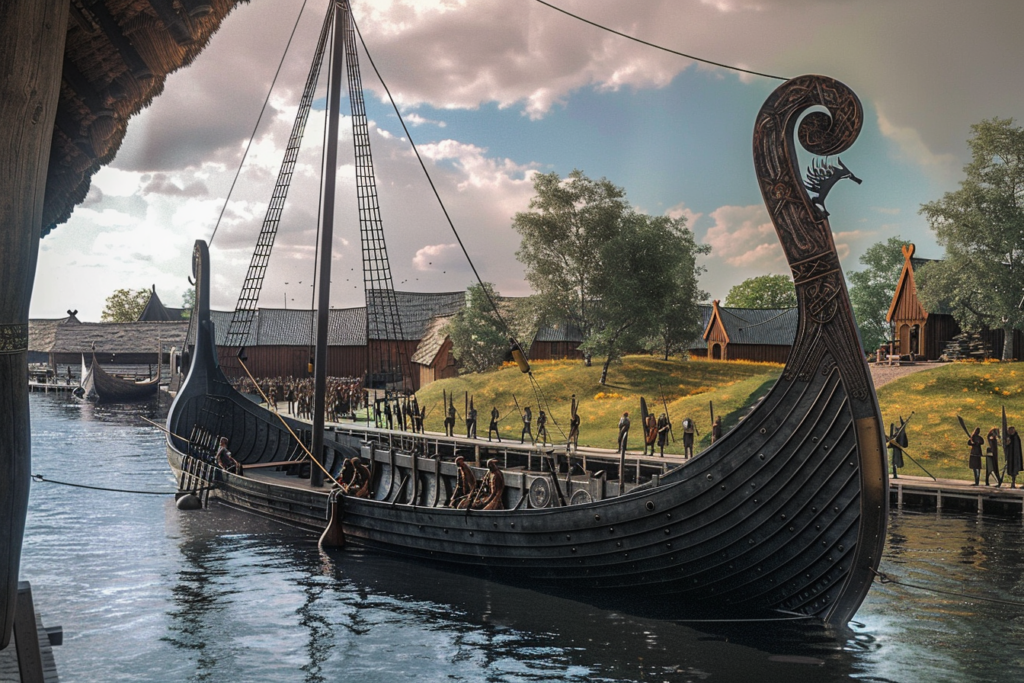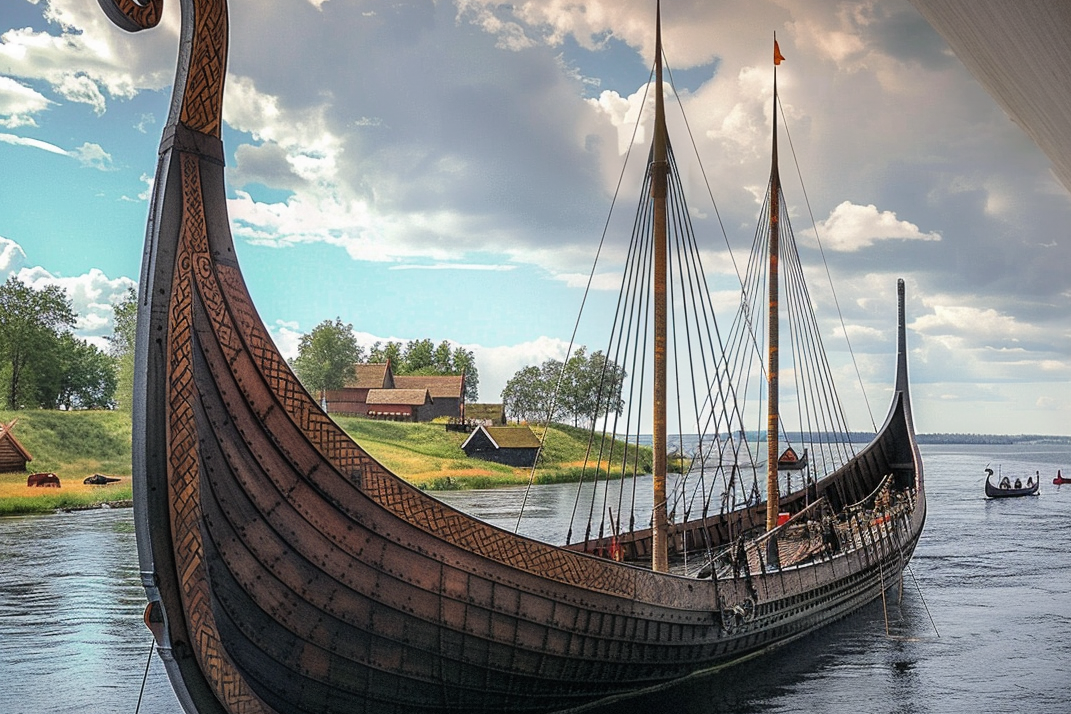The Oseberg Ship is a Viking Age artifact that is considered one of the most significant discoveries in the history of archaeology. The ship was discovered in 1903, in a burial mound on the Oseberg farm, near Tønsberg in Vestfold County, Norway.
The ship is believed to have been built around 820 AD and was used as a burial chamber for two women of high-ranking status who died around 834 AD.

The Oseberg Ship is a true showcase of Viking art, with its intricate carvings, detailed decorations, and lavish burial gifts. The ship is 21.40 meters long and 5.10 meters wide, and it contains 15 pairs of oar holes, which means up to 30 men could row the ship as required.
The vessel’s bow and stern are covered in elaborate carvings, which depict various scenes from Norse mythology, including the god Odin riding his eight-legged horse, Sleipnir.
The treasures of the Oseberg Ship offer a unique insight into the Viking Age and the lives of the people who lived during that time.
The burial gifts found in the ship include textiles, animal bones, household items, and even a sled. The most impressive of these treasures are the textiles, which are remarkably well-preserved and provide a glimpse into the clothing and weaving techniques of the Viking Age.
The Oseberg Ship Discovery

The Oseberg ship is a well-preserved Viking ship that was discovered in 1903 in Norway. The ship was found in a burial mound in the Oseberg farm, Tønsberg, Vestfold.
The discovery of the ship was a significant event in the history of archaeology and Viking studies.
Archaeological Excavation
The excavation of the Oseberg ship was carried out by archaeologist Gabriel Gustafson and his team. Gustafson was the director of the Museum of Antiquities in Oslo at the time.
The excavation of the ship was a challenging task due to the ship’s size and the condition of the burial mound.
The team had to remove over 5,000 cubic meters of soil to uncover the ship.
During the excavation, Gustafson and his team discovered many valuable artifacts, including textiles, wood carvings, and animal bones. The team also found the remains of two women who were buried with the ship.
The women were believed to be of high social status due to the lavish burial gifts that were found with them.
Significance of the Oseberg Find
The Oseberg ship is significant because it provides valuable insights into Viking culture, art, and craftsmanship. The ship is believed to have been built in the 9th century, and it is the oldest known Viking longship.
The ship’s design and construction reveal the advanced shipbuilding skills of the Vikings.
The artifacts found with the ship, including textiles, wood carvings, and metalwork, are excellent examples of Viking art and craftsmanship. The textiles found with the ship are particularly notable for their intricate designs and high quality.
The discovery of the Oseberg ship has also helped historians and archaeologists to gain a better understanding of Viking burial customs and social hierarchy.
The fact that the ship was used as a burial vessel for two high-status women suggests that women played an important role in Viking society.
Design and Construction

Craftsmanship and Materials
The Oseberg ship is a masterpiece of Viking craftsmanship and engineering. The ship was built using oak timber, a material that was highly valued for its strength and durability.
The planks of the ship were clinker built, which means they were overlapped and nailed together to form a watertight seal.
The ship was also equipped with a mast and sail, which allowed it to travel long distances quickly and efficiently.
The ship was constructed using a variety of tools and techniques, including axes, adzes, and chisels.
The planks were carefully shaped and fitted together to create a smooth, streamlined hull.
The ship’s intricate carvings and decorations were also crafted by skilled artisans, who used a variety of tools and techniques to create intricate designs and patterns.
Ship’s Features and Dimensions
The Oseberg ship is an impressive vessel, measuring approximately 21.5 meters long and 5 meters wide. The ship was launched in the year 820 and was used for both trading and raiding.
It was equipped with a single mast and sail, which allowed it to travel at speeds of up to 10 knots.
The ship was also equipped with 15 pairs of oars, which were used to propel the ship in calm or shallow waters.
The ship’s interior was also carefully designed and crafted.
It was divided into three sections, with the front and rear sections used for storage and the middle section used for living quarters.
The living quarters were equipped with a fireplace and cooking area, as well as sleeping quarters for the crew.
Burial Practices and Grave Goods
Oseberg Burial Chamber
The Oseberg Ship is a well-known ship burial that showcases the Viking’s elaborate funeral rituals. The ship was used as a burial chamber for two wealthy women who were sacrificed and buried with their possessions.
The burial chamber was located in a large mound and was constructed with wooden walls lined with textiles and animal skins.
The chamber contained two beds, a number of sledges, combs, and animal heads. The walls were adorned with tapestries, and the floors were covered with carpets.
The burial gifts were placed in the chamber, including a variety of household items, jewelry, and textiles.
Treasures and Artifacts
The Oseberg Ship contained many treasures and artifacts that give us insight into the Viking’s way of life. The ship was filled with a variety of objects, including a large number of textiles, combs, and animal heads.
The ship was also filled with a variety of household items, such as buckets, bowls, and spoons.
The ship contained a number of decorative objects, including tapestries, which were hung on the walls of the burial chamber.
The tapestries were made of wool and silk and were decorated with intricate designs. The ship also contained a number of carved wooden objects, including bedposts and sledges.
Conservation and Display

Preservation Efforts
The Oseberg ship is an incredibly important artifact from the Viking Age, and as such, its preservation is of utmost importance.
The ship was discovered in 1903 in a burial mound in Oseberg, near Tønsberg, Norway, and was excavated shortly thereafter. The ship and its accompanying burial goods were in remarkably good condition, due in large part to the blue clay in which they were buried.
However, over time, the ship began to deteriorate, and preservation efforts were necessary to ensure its longevity.
Conservationists and restoration experts have worked tirelessly to ensure the ship’s preservation.
The ship has undergone extensive scientific analysis, which has provided crucial insights into Viking maritime technology, burial customs, and preservation techniques.
The Ship at the Viking Ship Museum
Today, the Oseberg ship is on display at the Viking Ship Museum in Oslo, Norway. The museum is dedicated to preserving and showcasing the rich history of Viking culture. The Oseberg ship is one of its most prized possessions.
The ship is displayed in a specially designed climate-controlled room. This helps to protect it from the elements and ensures its continued preservation.
Visitors to the museum can view the ship up close and personal. They can even walk around its perimeter to get a sense of its size and scale. The ship is displayed alongside a number of other Viking artifacts, including weapons, jewelry, and household items. The museum also offers a variety of educational programs and exhibits. These help to bring the history of the Vikings to life for visitors of all ages.
The Oseberg ship is a remarkable testament to the ingenuity and craftsmanship of the Vikings. Its preservation and display at the Viking Ship Museum is a testament to the dedication and skill of the conservationists and restoration experts. They have worked tirelessly to ensure its longevity.










Add Comment